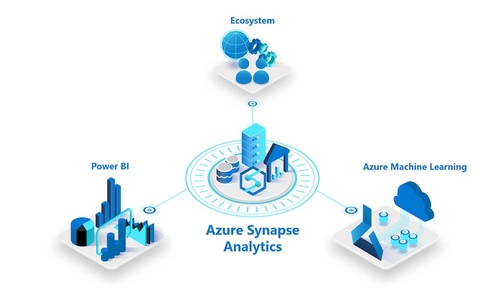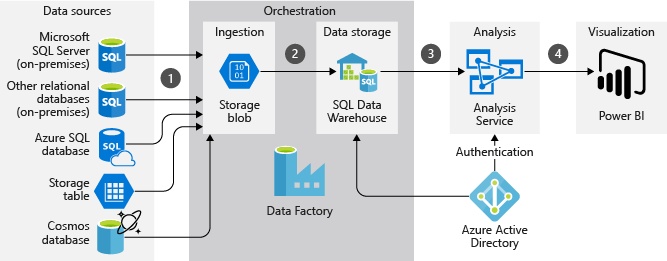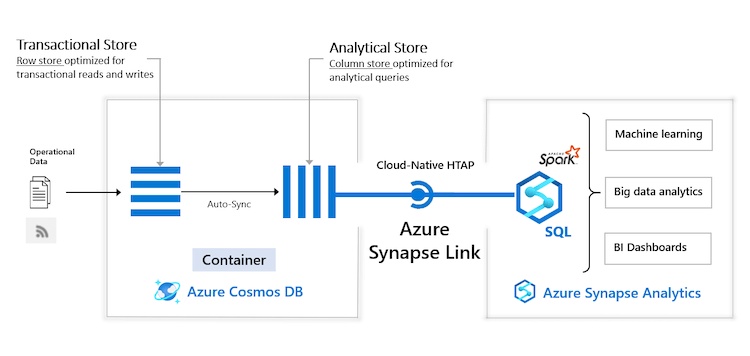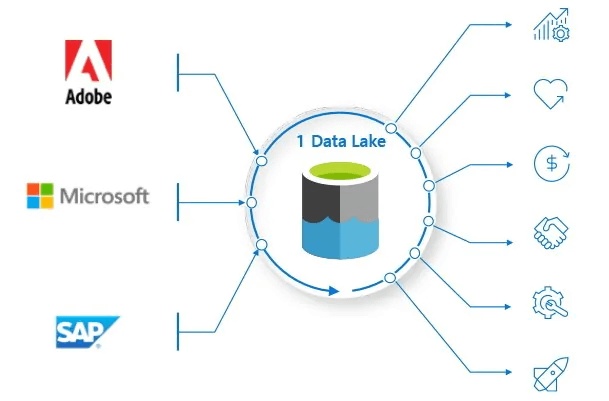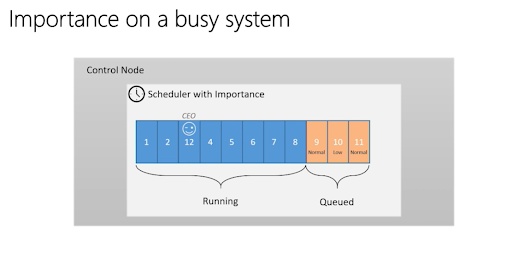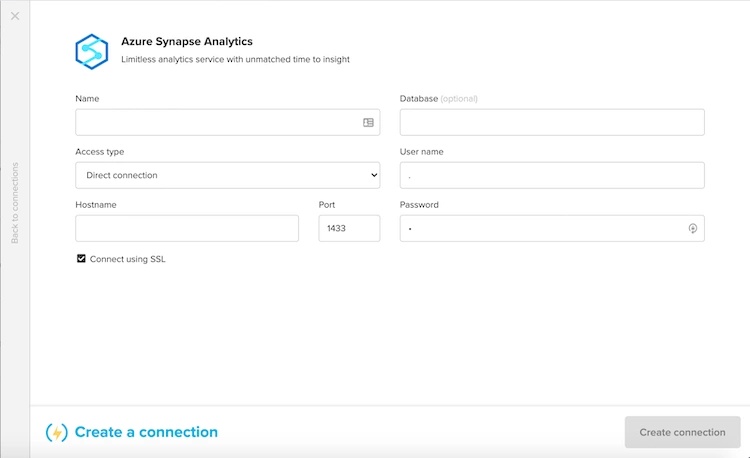Five things you should know about Azure Synapse Analytics:
- Azure Synapse Analytics is a data warehousing solution, business intelligence tool, and big data analytics platform all rolled into one.
- It supports all major data governance frameworks, allowing you to adhere to data protection standards and avoid penalties for non-compliance.
- It features native connectors for many Azure and non-Azure services.
- New features for 2022 include improvements to machine learning, four new database templates, and a new data connector for Microsoft Dynamics.
- You can move data to Azure Synapse Analytics with Integrate.io's native no-code connector.
Azure Synapse Analytics is a scalable, cloud-based data warehousing solution from Microsoft. Upon its launch, Microsoft described it as “the next iteration of Azure SQL Data Warehouse.” In addition to offering all of the technology and features of that platform, Azure Synapse also incorporates business intelligence, data analytics, and machine learning tools for both relational and non-relational data.
To help you better understand the awesome power and capabilities of this cutting-edge data warehouse and business analytics system – and to announce the release of Integrate.io’s native Azure Synapse Analytics connector – this guide will help you understand what Azure Synapse Analytics is, why it can support your data goals, and how to incorporate it into your tech stack.
Please use these links to navigate the guide:
- Overview of Azure Synapse Analytics
- Features of Azure Synapse Analytics
- When to Use Azure Synapse Analytics
- Integrate.io: ETL Data Into Azure Synapse Analytics the Easy Way
Integrate.io is the data integration platform that helps you move information such as e-commerce data to Azure Synapse Analytics. With powerful ETL, ELT, CDC, and ReverseETL capabilities, Integrate.io makes data integration simple. Email a team member to learn more.
Overview of Azure Synapse Analytics
If you’re familiar with Azure SQL Data Warehouse, you already know the core features of Synapse Analytics. For example, Synapse offers cloud-based, relational data warehousing services, massively parallel processing (MPP) scale-out technology, and enough computational power to efficiently manage petabytes and petabytes of data (just like SQL Data Warehouse).
In addition to these SQL Data Warehouse features, Synapse Analytics adds new capabilities like:
- The capability to ingest, save, query, and process non-relational data
- More integrations with Microsoft technologies
- Integrations with open data initiative compatible solutions
- Business intelligence integrations
- Machine learning integrations
- More efficient ingestion, transformation, management, and processing of large volume data
It’s also important to note that Azure Synapse Analytics can operate via the “on-demand serverless” model (which allows you to scale up or down and pay for only what you need when you need it), or it can operate on pre-provisioned server resources -- whichever is better for your budget and use-case.
As for operational components, Synapse consists of four fundamental parts:
- SQL analytics: Synapse offers T-SQL analysis of your relational and non-relational data via SQL Cluster (where you pay by the computational unit) and SQL on-demand (where you pay by the number of processed terabytes).
- Apache Spark: Apache Spark is the leading platform for managing SQL queries, batch processing, stream processing, predictive analytics, and machine learning models analysis on large data stores.
- Synapse Analytics Studio: Synapse Analytics Studio offers a unified workspace where you can use all of your analytics tools related to AI, ML, IoT, and BI in a single place.
- Connectors for ingesting/integrating data from data sources: Synapse features native connectors for integrating the most popular data sources so you can quickly ingest all of your data from diverse systems into the data warehouse. These native connectors include Amazon Redshift, Google BigQuery, MongoDB, Google AdWords, and GitHub.
| General Feature/Capability | Azure Synapse | Azure SQL Database | SQL Server (hosted on VM) | Apache Hive (hosted on HDInsight) | Hive LLAP (hosted on HDInsight) |
| Is it a relational data store? | √ | √ | √ | X | √ |
| Managed service? | √ | √ | X | √ | √ |
| Does it need data orchestration? | √ | X | X | √ | √ |
| SMP or MPP? | MPP | SMP | SMP | MPP | MPP |
| Does it have real-time reporting? | X | √ | √ | X | √ |
| Does it offer flexible backup restore points? | X | √ | √ | √ | √ |
| Can you integrate multiple data sources? | √ | X | X | √ | √ |
| Is pausing compute supported? | √ | X | X | X | X |
(Source)
Recommended reading: What Are the Top ETL Tools for Azure Data Warehouse?
Features of Azure Synapse Analytics
Let’s review the defining features of Azure Synapse Analytics:
Cloud Data Warehousing, Machine Learning Analytics, and Business Intelligence
Azure Synapse Analytics has deep integrations with a wide range of Microsoft Azure and Synapse technologies such as Azure Data Factory, Azure Data Explorer, Azure SQL Database, Synapse Studio, Synapse Workspace, CosmosDB, and Synapse SQL. It also offers cloud data warehousing, machine learning analytics, and dashboarding in a single workspace. This allows you to quickly ingest all of your data, transform and query it with SQL, analyze the data with advanced machine learning algorithms, and generate visualizations with Microsoft Power BI.
Recommended reading: What is a Data Warehouse and Why Are They Important?
Ingest and Query Both Structured and Unstructured Data
Azure Synapse ingests all types of data, including relational (data warehouse) data and non-relational (data lake) data, and it lets you explore this data with SQL. In this way, Synapse brings all of your structured and unstructured data (LOB, CRM, Graph, Image, Social, IoT, etc.) under the same roof for easy access and analysis. Now you don’t have to use several systems to analyze structured and unstructured data.
Azure Data Lake Storage Gen2
Azure Synapse uses Azure Data Lake Storage Gen2 (ADLS Gen2) as a next-level data storage solution to support large-volume data analytics. ADLS Gen2 combines ADLS Gen1 features (like file-level security, scaling and file system semantics) with Azure Blob Storage features such as tiered storage, disaster recovery, and high availability.
Massively Parallel Processing (MPP)
Azure Synapse uses massively parallel processing (MPP) database technology, which allows it to manage analytical workloads and aggregate and process large volumes of data efficiently. In contrast to transactional databases, which store rows in a table as an object, MPP databases store each column as an object. MPP databases also distribute data across many nodes that operate in parallel to process different portions of queries. This database architecture facilitates complex, long-running analytical processes.
Cloud-Native Hybrid Transaction/Analytical Processing (HTAP) Implementation
Azure Synapse Analytics uses “Synapse Link” and HTAP implementation technology to achieve real-time data integrations with the Azure databases that make up your operational database infrastructure. The result is real-time machine learning and business intelligence insights drawn from live, operational data – without impacting your operational systems.
According to Gartner, “HTAP will enable business leaders to perform, in the context of operational processes, much more advanced and sophisticated real-time analysis of their business data than with traditional architectures. Large volumes of complex business data can be analyzed in real-time using intuitive data exploration and analysis without the latency of offloading the data to a data mart or data warehouse. This will allow business users to make more informed operational and tactical decisions.”
On-Demand Serverless or Provisioned Processing Resources
Synapse gives you the ability to query massive data stores using either an on-demand serverless deployment (which scales automatically as needed to handle any processing or load) or provisioned resources. This allows organizations to either pay for what they need when they need it, or they can have a set amount of pre-provisioned processing and storage capabilities.
Programming Language Compatibility
Azure Synapse is compatible with the widest range of scripting languages – including Scala, Python, .Net, Java, R, SQL, T-SQL, and Spark SQL. Synapse’s compatibility with so many different languages makes it suitable for a wide range of analytics tasks and data engineering profiles.
Easy Integrations with Microsoft Technology
As a Microsoft Azure product, Synapse integrates natively with your favorite Microsoft and Azure solutions such as Azure Blob Storage, Azure Data Lake, Azure Active Directory, Azure Machine Learning, and Power BI.
Open Data Initiative Compatibility
Azure Synapse readily integrates with solutions that adhere to the Open Data Initiative, which promotes easier data integration and compatibility between Adobe, Microsoft, and SAP technologies. Open Data Initiative solutions include products like Microsoft Dynamics 365, Microsoft Office, and Adobe Customer Experience Platform.
Workload Optimization and Management Features
Synapse facilitates query performance tuning and optimization via limitless concurrency, workload isolation, and workload management. An example of how this works in terms of workload management could involve giving greater importance to queries from important users, like the CEO. In the following illustration, the CEO’s query gets automatically promoted from “queued” status to “running.”
Watch this video from Microsoft for more information about what Synapse can do in terms of workload optimization.
Security and Privacy
Synapse includes the latest security and privacy technology such as real-time data masking, dynamic data masking, always-on encryption, Azure Active Directory authentication, single-sign-on authentication, and automated threat detection. The platform also allows you to control access to sensitive data via column-level and row-level security.
Here’s a matrix comparison of the security features of Synapse Analytics and other solutions:
| Security Feature/Capability | Azure Synapse | Azure SQL Database | SQL Server (hosted on VM) | Apache Hive (hosted on HDInsight) | Hive LLAP (hosted on HDInsight) |
| What types of authentication? | SQL, Azure Active Directory | SQL, Azure Active Directory | SQL, Azure Active Directory | Local and Azure Active Directory | Local and Azure Active Directory |
| Is there row-level security? | √ | √ | √ | X | √ |
| Is there support for firewalls? | √ | √ | √ | √ | √ |
| Is there dynamic data masking? | √ | √ | √ | X | √ |
| Is there authorization? | √ | √ | √ | √ | √ |
| Is there auditing? | √ | √ | √ | √ | √ |
| Is there data encryption at rest? | √ | √ | √ | √ | √ |
(Source)
Compliance Certifications
Azure has more compliance certifications than any other cloud service provider. These compliance certifications allow your organization to adhere to the most stringent government and industry compliance standards.
| Global | US Government | Industry | Regional | ||
| CIS Benchmark | CJIS | 23 NYCRR Part 500 | HIPAA / HITECH | BIR 2012 (Netherlands) | LOPD (Spain) |
| CSA-STAR attestation | CNSSI 1253 | AFM + DNB (Netherlands) | HITRUST | C5 (Germany) | MeitY (India) |
| CSA-STAR certification | DFARS | APRA (Australia) | KNF (Poland) | CCPA (US-California) | MTCS (Singapore) |
| CSA-STAR self assessment | DoD DISA L2, L4, L5 | AMF and ACPR (France) | MARS-E | IRAP / CCSL (Australia) | My Number (Japan) |
| ISO 20000-1:2011 | DoE 10 CFR Part 810 | CDSA | MAS + ABS (Singapore) | CS Mark Gold (Japan) | NZ CC Framework (New Zealand) |
| ISO 22301 | EAR (US Export Adm. Reg.) | CFTC 1.31 (US) | MPAA | Cyber Essentials Plus (UK) | PASF (UK) |
| ISO 27001 | FedRAMP | DPP (UK) | NBB + FSMA (Belgium) | Canadian Privacy Laws | PDPA (Argentina) |
| ISO 27017 | FIPS 140-2 | EBA (EU) | NEN-7510 (Netherlands) | DJCP (China) | Personal Data Localization (Russia) |
| ISO 27018 | IRS 1075 | FACT (UK) | NERC | EN 301 549 (EU) | TRUCS (China) |
| ISO 27701 | ITAR | FCA (UK) | OSFI (Canada) | ENS (Spain) | |
| ISO 9001 | NIST 800-171 | FDA CFR Title 21 Part 11 | PCI DSS | ENISA IAF (EU) | |
| SOC | NIST CSF | FERPA | RBI + IRDAI (India) | EU Model Clauses | |
| WCAG | Section 508 VPATS | FFIEC (US) | SEC 17a-4 | EU-US Privacy Shield | |
| FINMA (Switzerland) | SEC Regulation SCI | GB 18030 (China) | |||
| FINRA 4511 | Shared assessments | GDPR (EU) | |||
| FISC (Japan) | SOX | G-Cloud (UK) | |||
| FSA (Denmark) | TISAX (Germany) | IDW PS 951 (Germany) | |||
| GLBA | TruSight | ISMS (Korea) | |||
| GxP | HDS (France) | IT Grundschutz Workbook (Germany) | |||
(Source)
When to Use Azure Synapse Analytics
Here are some general use-case scenarios where Azure Synapse Analytics may be useful:
- Need for a managed service: Azure Synapse can serve as your managed cloud-based data warehouse instead of an on-site data warehouse that you have to maintain yourself.
- Large data sets and complex queries: Azure Synapse Analytics uses an MPP architecture (see above), which is excellent for managing large datasets while running complicated read and data analytics operations.
- Managing structured and unstructured datasets: If you’re dealing with unstructured data or a mix of structured and unstructured data, Azure Synapse integrates with Azure Data Analytics, which allows you to process unstructured data with Spark, Azure Databricks, Hive LLAP, and Azure Data Lakes Analytics. Azure Synapse also supports high-speed, compute-heavy read operations on structured data.
- Data pipeline orchestration: Azure Synapse Analytics allows you to orchestrate data pipelines in order to separate historical data (into a data warehouse optimized for high-speed read operations) from real-time operational databases.
- Analytics on real-time operational data: Azure Synapse Analytics’ use of “Synapse Link” and HTAP implementation technology allows you to analyze real-time operational data without negatively impacting your operational systems.
- Using many Microsoft and Azure services: If your organization already subscribes to and uses services within the Microsoft and Azure ecosystems, you’ll enjoy the fact that Synapse easily integrates with these services.
Integrate.io: ETL Data Into Azure Synapse Analytics the Easy Way
If you’re planning to use Azure Synapse Analytics to service your data warehousing, analytics, and business intelligence needs, you’ll need a way to quickly and easily move your data from diverse systems into the service. This is where Integrate.io’s easy-to-use Azure Synapse Analytics connector can help.
Microsoft recently announced new features for Azure Synapse Analytics for 2022. These features include:
- Improvements to machine learning
- Four new database templates
- A new native data flow connector for Microsoft Dynamics
- Serverless SQL now support HASHBYTES
Thinking of moving data to Azure Synapse Analytics? Integrate.io lets you do it without complicated code or manual data pipelines. Email a team member to learn more.
Recommended reading: Why Data Engineers Should Consider Microsoft Azure
When to Use Azure Synapse Analytics
Here are some general use-case scenarios where Azure Synapse Analytics may be useful:
- Need for a managed service: Azure Synapse can serve as your managed cloud-based data warehouse instead of an on-site data warehouse that you have to maintain yourself. That lets you store data in a centralized location and analyze that data without worrying about the cost of physical infrastructure.
- Large data sets and complex queries: Azure Synapse Analytics uses an MPP architecture (see above), which is excellent for managing large datasets while running complicated read and data analytics operations. For example, you can send large loads of e-commerce data to the platform and generate intelligence about customers.
- Managing structured and unstructured datasets: If you’re dealing with unstructured data or a mix of structured and unstructured data, Azure Synapse integrates with Azure Data Analytics, which allows you to process unstructured data with Spark, Azure Databricks, Hive LLAP, and Azure Data Lakes Analytics. Azure Synapse also supports high-speed, compute-heavy read operations on structured data.
- Data pipeline orchestration: Azure Synapse Analytics allows you to orchestrate data pipelines in order to separate historical data (into a data warehouse optimized for high-speed read operations) from real-time operational databases.
- Analytics on real-time operational data: Azure Synapse Analytics’ use of “Synapse Link” and HTAP implementation technology allows you to analyze real-time operational data without negatively impacting your operational systems.
- Using many Microsoft and Azure services: If your organization already subscribes to and uses services within the Microsoft and Azure ecosystems, you’ll enjoy the fact that Synapse easily integrates with these services.
Integrate.io: ETL Data Into Azure Synapse Analytics the Easy Way
If you’re planning to use Azure Synapse Analytics to service your data warehousing, analytics, and business intelligence needs, you’ll need a way to quickly and easily move your data from diverse systems into this limitless analyticse service. This is where Integrate.io’s easy-to-use Azure Synapse Analytics connector can help.
Integrate.io is a new ETL platform that moves data to Azure Synapse Analytics without the stress. Its out-of-the-box native connector requires no code, so you can transfer data to Synapse Analytics without any programming, enterprise data warehousing, or data engineering experience. You can build sophisticated data pipelines that extract, join, cleanse, aggregate, mask, and encrypt data from diverse systems while adhering to data compliance frameworks.
It’s not just ETL. Integrate.io offers other data integration techniques such as ReverseETL, which lets you move data from Azure Synapse Analytics to an operational system such as a SaaS tool or on-premises software. You can also transfer data via ELT and a super-fast CDC tool without worrying about complicated concepts such as data science, caching, data replication, or DevOps.
Integrate.io’s deep e-commerce capabilities also help you integrate customer and product data to other data warehousing and analytics solutions such as Redshift, Snowflake, and Google BigQuery. By moving your data to a single location and running it through analytics services, you can improve e-commerce tasks in your organization and generate unparalleled business insights without data scientists.
Integrate.io’s unique pricing structure means you only pay for the data connectors you use, not the amount of data you consume. That could work out cheaper than using other tools. Other benefits include world-class customer service, tutorials, and an easy-to-use data platform.
With Integrate.io’s newly-released native connector for Azure Synapse Analytics, anyone on your team – regardless of their data engineering skill level – can develop powerful ETL pipelines to your Azure Synapse Analytics data warehouse. Want to see how easy it is to use Integrate.io for yourself? Contact the Integrate.io team to schedule a seven-day free trial now and learn more about the Integrate.io story.
Some images used courtesy of Microsoft
